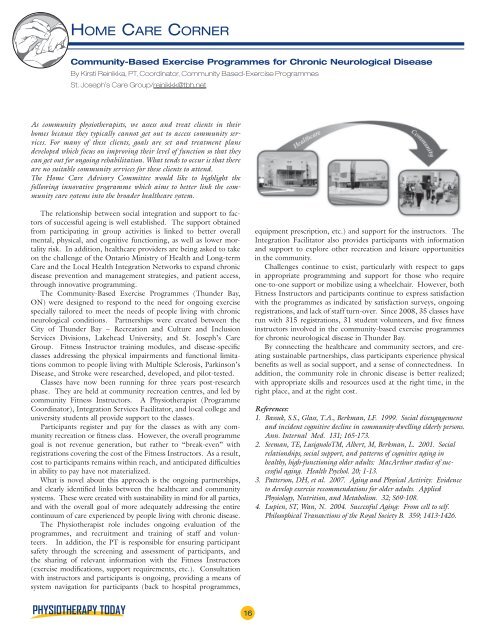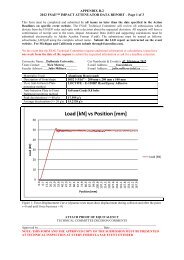2011 APTEI Acupuncture & Dry Needling (ADN) Program
2011 APTEI Acupuncture & Dry Needling (ADN) Program
2011 APTEI Acupuncture & Dry Needling (ADN) Program
Create successful ePaper yourself
Turn your PDF publications into a flip-book with our unique Google optimized e-Paper software.
hOMe Care COrner<br />
Community-Based Exercise <strong>Program</strong>mes for Chronic Neurological Disease<br />
By Kirsti Reinikka, PT, Coordinator, Community Based-Exercise <strong>Program</strong>mes<br />
St. Joseph’s Care Group/reinikkk@tbh.net<br />
As community physiotherapists, we assess and treat clients in their<br />
homes because they typically cannot get out to access community services.<br />
For many of these clients, goals are set and treatment plans<br />
developed which focus on improving their level of function so that they<br />
can get out for ongoing rehabilitation. What tends to occur is that there<br />
are no suitable community services for these clients to attend.<br />
The Home Care Advisory Committee would like to highlight the<br />
following innovative programme which aims to better link the community<br />
care systems into the broader healthcare system.<br />
The relationship between social integration and support to factors<br />
of successful ageing is well established. The support obtained<br />
from participating in group activities is linked to better overall<br />
mental, physical, and cognitive functioning, as well as lower mortality<br />
risk. In addition, healthcare providers are being asked to take<br />
on the challenge of the Ontario Ministry of Health and Long-term<br />
Care and the Local Health Integration Networks to expand chronic<br />
disease prevention and management strategies, and patient access,<br />
through innovative programming.<br />
The Community-Based Exercise <strong>Program</strong>mes (Thunder Bay,<br />
ON) were designed to respond to the need for ongoing exercise<br />
specially tailored to meet the needs of people living with chronic<br />
neurological conditions. Partnerships were created between the<br />
City of Thunder Bay – Recreation and Culture and Inclusion<br />
Services Divisions, Lakehead University, and St. Joseph’s Care<br />
Group. Fitness Instructor training modules, and disease-specific<br />
classes addressing the physical impairments and functional limitations<br />
common to people living with Multiple Sclerosis, Parkinson’s<br />
Disease, and Stroke were researched, developed, and pilot-tested.<br />
Classes have now been running for three years post-research<br />
phase. They are held at community recreation centres, and led by<br />
community Fitness Instructors. A Physiotherapist (<strong>Program</strong>me<br />
Coordinator), Integration Services Facilitator, and local college and<br />
university students all provide support to the classes.<br />
Participants register and pay for the classes as with any community<br />
recreation or fitness class. However, the overall programme<br />
goal is not revenue generation, but rather to “break-even” with<br />
registrations covering the cost of the Fitness Instructors. As a result,<br />
cost to participants remains within reach, and anticipated difficulties<br />
in ability to pay have not materialized.<br />
What is novel about this approach is the ongoing partnerships,<br />
and clearly identified links between the healthcare and community<br />
systems. These were created with sustainability in mind for all parties,<br />
and with the overall goal of more adequately addressing the entire<br />
continuum of care experienced by people living with chronic disease.<br />
The Physiotherapist role includes ongoing evaluation of the<br />
programmes, and recruitment and training of staff and volunteers.<br />
In addition, the PT is responsible for ensuring participant<br />
safety through the screening and assessment of participants, and<br />
the sharing of relevant information with the Fitness Instructors<br />
(exercise modifications, support requirements, etc.). Consultation<br />
with instructors and participants is ongoing, providing a means of<br />
system navigation for participants (back to hospital programmes,<br />
16<br />
equipment prescription, etc.) and support for the instructors. The<br />
Integration Facilitator also provides participants with information<br />
and support to explore other recreation and leisure opportunities<br />
in the community.<br />
Challenges continue to exist, particularly with respect to gaps<br />
in appropriate programming and support for those who require<br />
one-to-one support or mobilize using a wheelchair. However, both<br />
Fitness Instructors and participants continue to express satisfaction<br />
with the programmes as indicated by satisfaction surveys, ongoing<br />
registrations, and lack of staff turn-over. Since 2008, 35 classes have<br />
run with 315 registrations, 31 student volunteers, and five fitness<br />
instructors involved in the community-based exercise programmes<br />
for chronic neurological disease in Thunder Bay.<br />
By connecting the healthcare and community sectors, and creating<br />
sustainable partnerships, class participants experience physical<br />
benefits as well as social support, and a sense of connectedness. In<br />
addition, the community role in chronic disease is better realized;<br />
with appropriate skills and resources used at the right time, in the<br />
right place, and at the right cost.<br />
References:<br />
1. Bassuk, S.S., Glass, T.A., Berkman, LF. 1999. Social disengagement<br />
and incident cognitive decline in community-dwelling elderly persons.<br />
Ann. Internal Med. 131; 165-173.<br />
2. Seeman, TE, LusignoloTM, Albert, M, Berkman, L. 2001. Social<br />
relationships, social support, and patterns of cognitive aging in<br />
healthy, high-functioning older adults: MacArthur studies of successful<br />
aging. Health Psychol. 20; 1-13.<br />
3. Patterson, DH, et al. 2007. Aging and Physical Activity: Evidence<br />
to develop exercise recommendations for older adults. Applied<br />
Physiology, Nutrition, and Metabolism. 32; S69-108.<br />
4. Lupien, ST, Wan, N. 2004. Successful Aging: From cell to self.<br />
Philosophical Transactions of the Royal Society B. 359; 1413-1426.



